Intel Core i7-11700K Review: Blasting Off with Rocket Lake
by Dr. Ian Cutress on March 5, 2021 4:30 PM EST- Posted in
- CPUs
- Intel
- 14nm
- Xe-LP
- Rocket Lake
- Cypress Cove
- i7-11700K
CPU Tests: Encoding
One of the interesting elements on modern processors is encoding performance. This covers two main areas: encryption/decryption for secure data transfer, and video transcoding from one video format to another.
In the encrypt/decrypt scenario, how data is transferred and by what mechanism is pertinent to on-the-fly encryption of sensitive data - a process by which more modern devices are leaning to for software security.
Video transcoding as a tool to adjust the quality, file size and resolution of a video file has boomed in recent years, such as providing the optimum video for devices before consumption, or for game streamers who are wanting to upload the output from their video camera in real-time. As we move into live 3D video, this task will only get more strenuous, and it turns out that the performance of certain algorithms is a function of the input/output of the content.
HandBrake 1.32: Link
Video transcoding (both encode and decode) is a hot topic in performance metrics as more and more content is being created. First consideration is the standard in which the video is encoded, which can be lossless or lossy, trade performance for file-size, trade quality for file-size, or all of the above can increase encoding rates to help accelerate decoding rates. Alongside Google's favorite codecs, VP9 and AV1, there are others that are prominent: H264, the older codec, is practically everywhere and is designed to be optimized for 1080p video, and HEVC (or H.265) that is aimed to provide the same quality as H264 but at a lower file-size (or better quality for the same size). HEVC is important as 4K is streamed over the air, meaning less bits need to be transferred for the same quality content. There are other codecs coming to market designed for specific use cases all the time.
Handbrake is a favored tool for transcoding, with the later versions using copious amounts of newer APIs to take advantage of co-processors, like GPUs. It is available on Windows via an interface or can be accessed through the command-line, with the latter making our testing easier, with a redirection operator for the console output.
We take the compiled version of this 16-minute YouTube video about Russian CPUs at 1080p30 h264 and convert into three different files: (1) 480p30 ‘Discord’, (2) 720p30 ‘YouTube’, and (3) 4K60 HEVC.
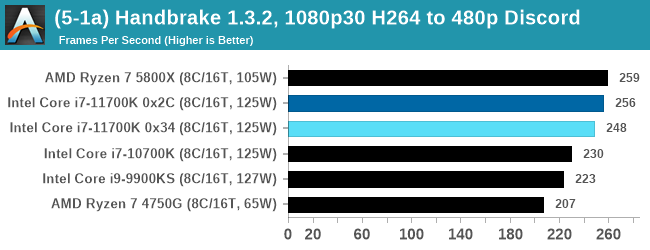
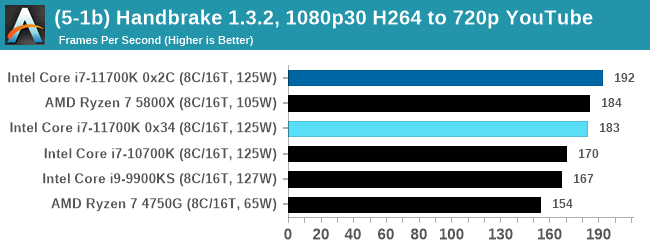
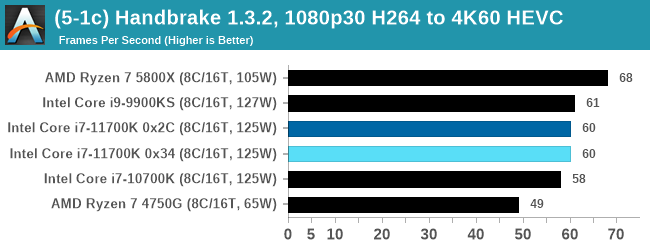
Up to the final 4K60 HEVC, in CPU-only mode, the Intel CPU puts up some good gen-on-gen numbers.
7-Zip 1900: Link
The first compression benchmark tool we use is the open-source 7-zip, which typically offers good scaling across multiple cores. 7-zip is the compression tool most cited by readers as one they would rather see benchmarks on, and the program includes a built-in benchmark tool for both compression and decompression.
The tool can either be run from inside the software or through the command line. We take the latter route as it is easier to automate, obtain results, and put through our process. The command line flags available offer an option for repeated runs, and the output provides the average automatically through the console. We direct this output into a text file and regex the required values for compression, decompression, and a combined score.
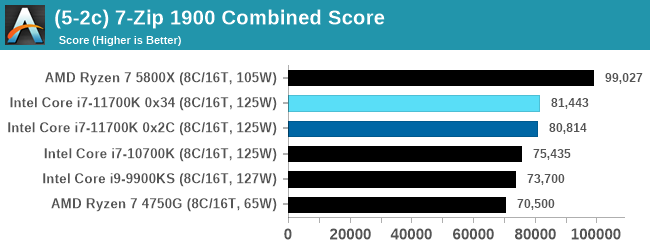
An increase over the previous generation, but AMD has a 25% lead.
AES Encoding
Algorithms using AES coding have spread far and wide as a ubiquitous tool for encryption. Again, this is another CPU limited test, and modern CPUs have special AES pathways to accelerate their performance. We often see scaling in both frequency and cores with this benchmark. We use the latest version of TrueCrypt and run its benchmark mode over 1GB of in-DRAM data. Results shown are the GB/s average of encryption and decryption.
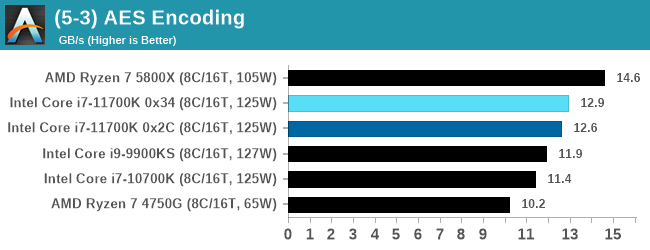
WinRAR 5.90: Link
For the 2020 test suite, we move to the latest version of WinRAR in our compression test. WinRAR in some quarters is more user friendly that 7-Zip, hence its inclusion. Rather than use a benchmark mode as we did with 7-Zip, here we take a set of files representative of a generic stack
- 33 video files , each 30 seconds, in 1.37 GB,
- 2834 smaller website files in 370 folders in 150 MB,
- 100 Beat Saber music tracks and input files, for 451 MB
This is a mixture of compressible and incompressible formats. The results shown are the time taken to encode the file. Due to DRAM caching, we run the test for 20 minutes times and take the average of the last five runs when the benchmark is in a steady state.
For automation, we use AHK’s internal timing tools from initiating the workload until the window closes signifying the end. This means the results are contained within AHK, with an average of the last 5 results being easy enough to calculate.
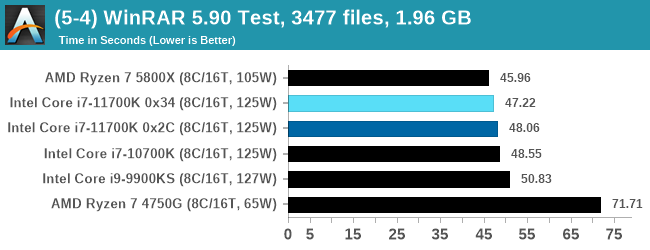
CPU Tests: Legacy and Web
In order to gather data to compare with older benchmarks, we are still keeping a number of tests under our ‘legacy’ section. This includes all the former major versions of CineBench (R15, R11.5, R10) as well as x264 HD 3.0 and the first very naïve version of 3DPM v2.1. We won’t be transferring the data over from the old testing into Bench, otherwise it would be populated with 200 CPUs with only one data point, so it will fill up as we test more CPUs like the others.
The other section here is our web tests.
Web Tests: Kraken, Octane, and Speedometer
Benchmarking using web tools is always a bit difficult. Browsers change almost daily, and the way the web is used changes even quicker. While there is some scope for advanced computational based benchmarks, most users care about responsiveness, which requires a strong back-end to work quickly to provide on the front-end. The benchmarks we chose for our web tests are essentially industry standards – at least once upon a time.
It should be noted that for each test, the browser is closed and re-opened a new with a fresh cache. We use a fixed Chromium version for our tests with the update capabilities removed to ensure consistency.
Mozilla Kraken 1.1
Kraken is a 2010 benchmark from Mozilla and does a series of JavaScript tests. These tests are a little more involved than previous tests, looking at artificial intelligence, audio manipulation, image manipulation, json parsing, and cryptographic functions. The benchmark starts with an initial download of data for the audio and imaging, and then runs through 10 times giving a timed result.
We loop through the 10-run test four times (so that’s a total of 40 runs), and average the four end-results. The result is given as time to complete the test, and we’re reaching a slow asymptotic limit with regards the highest IPC processors.
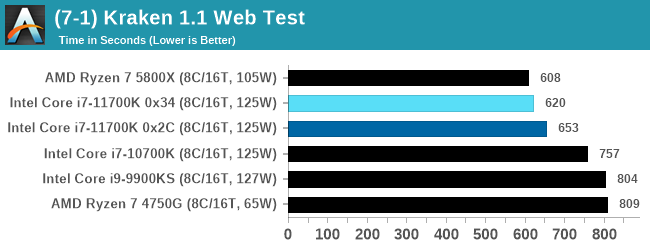
Google Octane 2.0
Our second test is also JavaScript based, but uses a lot more variation of newer JS techniques, such as object-oriented programming, kernel simulation, object creation/destruction, garbage collection, array manipulations, compiler latency and code execution.
Octane was developed after the discontinuation of other tests, with the goal of being more web-like than previous tests. It has been a popular benchmark, making it an obvious target for optimizations in the JavaScript engines. Ultimately it was retired in early 2017 due to this, although it is still widely used as a tool to determine general CPU performance in a number of web tasks.
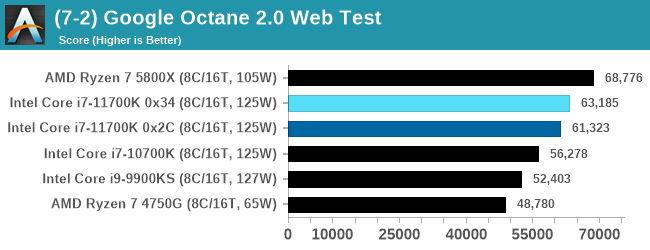
Speedometer 2: JavaScript Frameworks
Our newest web test is Speedometer 2, which is a test over a series of JavaScript frameworks to do three simple things: built a list, enable each item in the list, and remove the list. All the frameworks implement the same visual cues, but obviously apply them from different coding angles.
Our test goes through the list of frameworks, and produces a final score indicative of ‘rpm’, one of the benchmarks internal metrics.
We repeat over the benchmark for a dozen loops, taking the average of the last five.
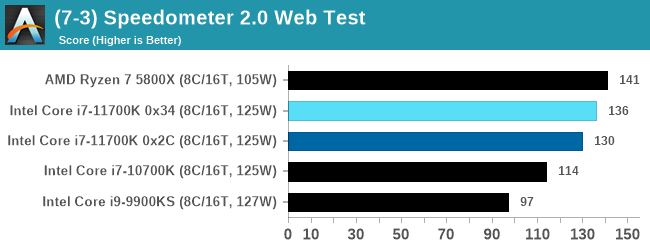
Legacy Tests
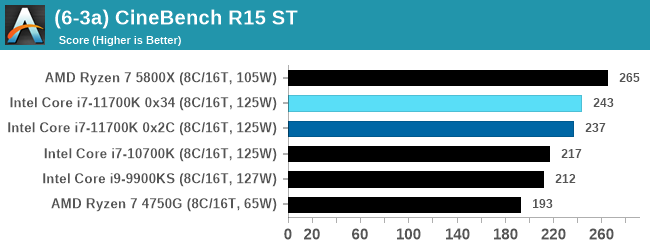
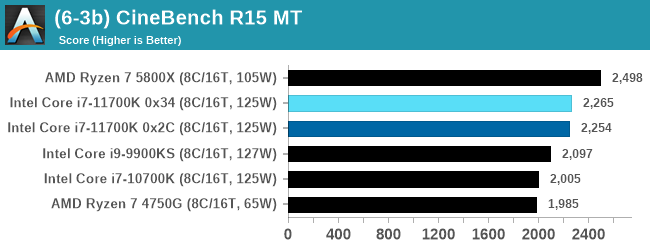
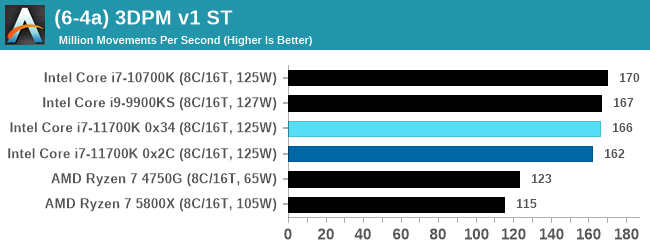
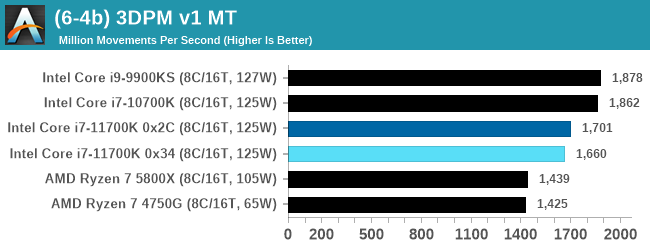


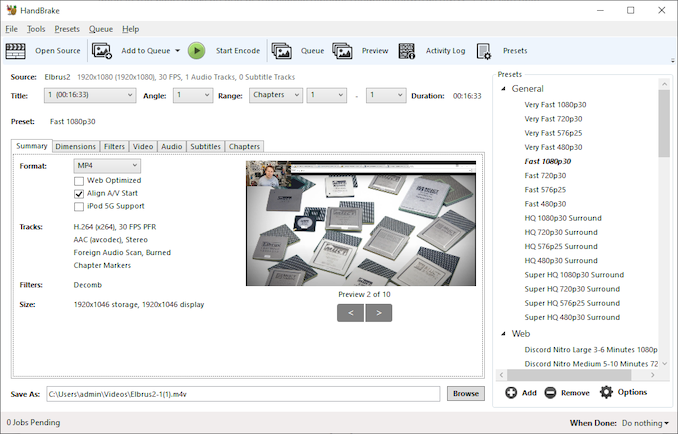
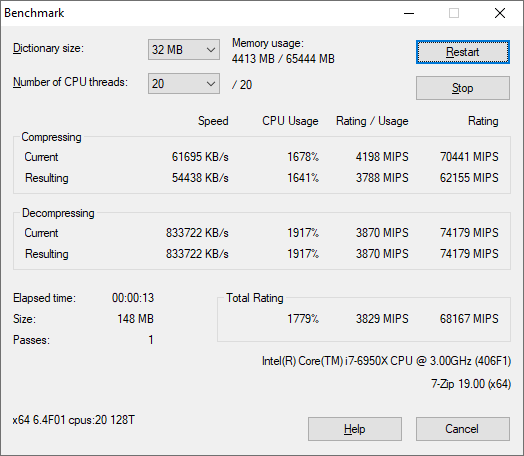
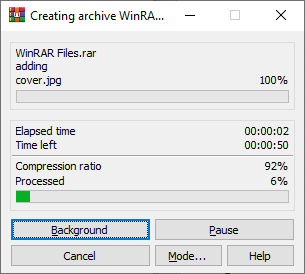

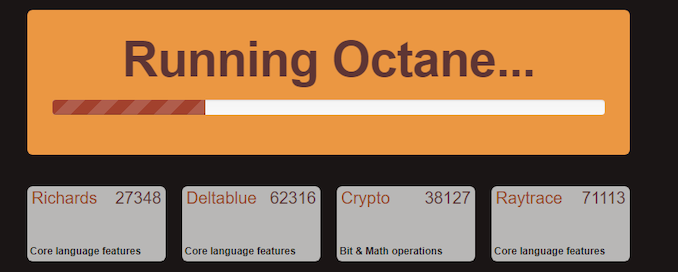
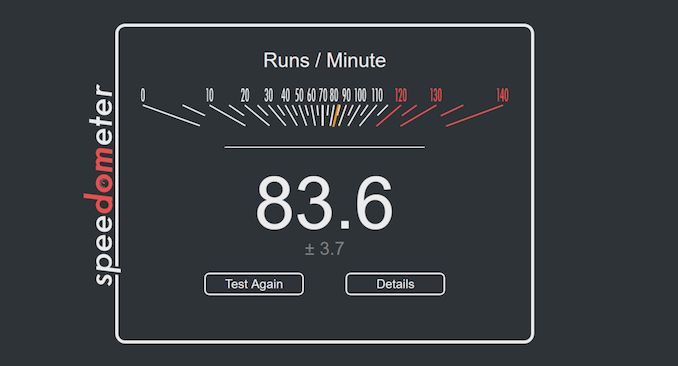








541 Comments
View All Comments
ottonis - Saturday, March 6, 2021 - link
How is Ryzen 5800x AMD's "best of the best"?It clearly is not but just about somewhere in the middle. If you want AMD's best consumer CPU, you gonna look at the 5950x.
From the perspective of AMD, completely outsourcing manufacturing was the only way to reap the benefits of latest and greatest process nodes.
Now, that everybody else, incl. the automobile industry, the consoles, Apple, and even Intel are booking production capacities at TMSC, has certainly contributed to Reaching capacity limits and thus to AMD CPU shortages.
It is predicted that shortages will be mostly (hopefully) sorted out by this summer.
But yes, now that AMD are earning quite a lot of money they should buy some TSMC stock and try to partner up, getting more production capacity in the future.
Fulljack - Saturday, March 6, 2021 - link
did you just forgetting why AMD spin-off it's fab on the first place?we don't know exactly how much AMD put out their desktop chips from TSMC plant, and as far as we know, the market are still growing in size. while AMD market share are still a long way from reaching 50%, they still have their processor sold out all over the place.
honestly I don't get what you're trying to say here.
shady28 - Saturday, March 6, 2021 - link
Actually we do know, they made ~1M Zen 3 chips in Q4. 140M PCs were shipped. Based on their market share, about 3% of the chips AMD shipped in Q4 were Zen 3.Source:https://wccftech.com/amd-shipped-nearly-1-million-...
inighthawki - Monday, March 8, 2021 - link
5800X = "Best of the best"11700K = "medium level SKU"
Your bias is showing.
Bluetooth - Saturday, March 6, 2021 - link
Does any one know the details of Intels 10 nm node problems. Any article discussing that in technical details?dihartnell - Thursday, March 11, 2021 - link
I think adored tv did a few articles, videos on this. As I understand it thier main issues are they use a monolithic die (everything on on a single die) that gets harder to make as the process shrinks, IE more dies have defects... AMD got around this by going chiplet, lots of small dies which meant more of them are good. Until Intel chnages to chiplet or they find a way to improve the manufacturing process to lower the defect rate then they will struggle.Santoval - Saturday, March 6, 2021 - link
Class action for what, excessive power bills? :) Imagine using this during a heatwave in an airless room. Since it doubles as a heater you would need to have the AC on all the time. If you have no AC there will be a competition between who dies first, you or the processor? ^.^sabot00 - Friday, March 5, 2021 - link
Indeed! I have been reading nothing but wccftech and Tom's leaks. Absolutely amazing surprise this Friday night while searching Rocket LakeBeaver M. - Saturday, March 6, 2021 - link
I would be very cautious testing or believing results with the Z590 platforms long before Rocket Lakes official release.Ive tested 3 of those boards with my Comet Lake (Asus, MSI and ASRock) and they all had pretty bad BIOS versions still, with PCIe/IO performance being low in SSD 4K benchmarks and getting weird frame time stutters from time to time (only noticeable when actually playing or looking at a realtime graph). Not to mention Intels drivers are still bad as well.
On none of them even very basic features like the sleep state worked!
Comparing this review with user benchmarks in German forums shows huge differences, so theres not much to add to this.
That said, I have to laugh when Americans or people from other countries with cheap power complain about the power draw.
And seeing fanboys downplay the performance of AVX and ignoring that it was always power hungry, even 6 years ago, is another obvious thing. Without it RKL actually runs pretty cool for being ancient 14nm.
And of course I love the geniuses who still think that you cant use the iGPU without it being connected to a monitor, or dont know about the new power saving/GPU switching feature. Not that this article didnt fail at pretty much everything, incl. explaining things like that.
Gigaplex - Saturday, March 6, 2021 - link
"That said, I have to laugh when Americans or people from other countries with cheap power complain about the power draw."Electricity is expensive where I live, but that's not why I want low power consumption. The more power it consumes, the louder the cooling solution will be. That's why my last system was Intel (Ivy Bridge) and my current system is AMD (Zen 3).